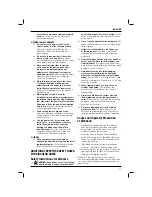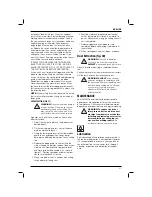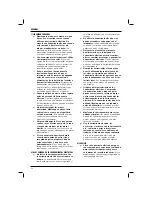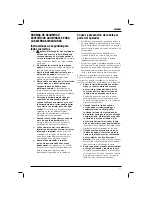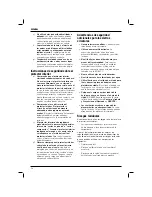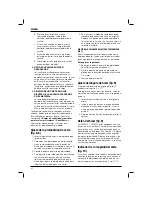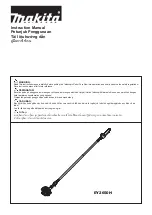
ENGLISH
51
put a heavy load on the saw. When this happens,
push the saw more slowly, but hard enough to keep
working without much decrease in speed. Forcing
the saw can cause rough cuts, inaccuracy, kickback,
and over-heating of the motor. Should your cut
begin to go off the line, don’t try to force it back
on. Release the switch and allow blade to come to
a complete stop. Then you can withdraw the saw,
sight anew, and start a new cut slightly inside the
wrong one. In any event, withdraw the saw if you
must shift the cut. Forcing a correction inside the cut
can stall the saw and lead to kickback.
IF SAW STALLS, RELEASE THE TRIGGER AND
BACK THE SAW UNTIL IT IS LOOSE. BE SURE
BLADE IS STRAIGHT IN THE CUT AND CLEAR OF
THE CUTTING EDGE BEFORE RESTARTING.
As you finish a cut, release the trigger and allow the
blade to stop before lifting the saw from the work.
As you lift the saw, the spring-tensioned telescoping
guard will automatically close under the blade.
Remember the blade is exposed until this occurs.
Never reach under the work for any reason. When
you have to retract the telescoping guard manually
(as is necessary for starting pocket cuts) always use
the retracting lever.
NOTE:
When cutting thin strips, be careful to ensure
that small cutoff pieces don’t hang up on inside of
lower guard.
POCKET CUTTING (FIG. 27)
WARNING:
Never tie the blade guard in
a raised position. Never move the saw
backwards when pocket cutting. This
may cause the unit to raise up off the
work surface which could cause injury.
A pocket cut is one that is made in a floor, wall or
other flat surface.
1. Adjust the saw base plate so the blade cuts at
desired depth.
2. Tilt the saw forward and rest front of the base
plate on material to be cut.
3. Using the lower guard lever, retract lower blade
guard to an upward position. Lower rear of
base plate until blade teeth almost touch cutting
line.
4. Release the blade guard (its contact with the
work will keep it in position to open freely as you
start the cut). Remove hand from guard lever
and firmly grip auxiliary handle (f), as shown in
figure 27. Position your body and arm to allow
you to resist kickback if it occurs.
5. Make sure blade is not in contact with cutting
surface before starting saw.
6. Start the motor and gradually lower the saw
until its base plate rests flat on the material to
be cut. Advance saw along the cutting line until
cut is completed.
7. Release trigger and allow blade to stop
completely before withdrawing the blade from
the material.
8. When starting each new cut, repeat as above.
Dust Extraction (fi g. 30)
WARNING:
Risk of dust inhalation.
To reduce the risk of personal injury,
ALWAYS
wear an approved dust mask.
A dust extraction spout (gg) is supplied with your
tool.
Vacuum hoses of most common vacuum extractors
will fit directly into the dust extraction spout.
WARNING: ALWAYS
use a vacuum
extractor designed in compliance with
the applicable directives regarding dust
emission when sawing wood. Vacuum
hoses of most common vacuum
cleaners will fit directly into the dust
extraction outlet.
MAINTENANCE
Your D
E
WALT power tool has been designed to
operate over a long period of time with a minimum
of maintenance. Continuous satisfactory operation
depends upon proper tool care and regular cleaning.
WARNING: To reduce the risk of
injury, turn unit off and disconnect
machine from power source before
installing and removing accessories,
before adjusting or changing set-
ups or when making repairs.
An
accidental start-up can cause injury.
Lubrication
Self lubricating ball and roller bearings are used in
the tool and relubrication is not required. However,
it is recommended that, once a year, you take or
send the tool to a service center for a thorough
cleaning, inspection and lubrication of the gear
case.
Summary of Contents for DWE575
Page 1: ...www eu DWE575 DWE576 ...
Page 3: ...1 Figure 1 jj h d a e b c g k j i f m l DWE576 aa z DWE575 h ...
Page 4: ...2 d p c q Figure 4 Figure 6 s r q t Figure 3 Figure 5 l j n k o Figure 7 Figure 2 ...
Page 5: ...3 Figure 9 Figure 8 Figure 10 g h u v w DWE575 DWE576 ...
Page 6: ...4 Figure 11 Figure 12 bb dd cc Figure 13 gg gg gg x y i m ...
Page 7: ...5 Figure 15 ff bb 100 mm 20 mm Figure 14 ee ee bb DWE576 DWE576 ...
Page 8: ...6 Figure 17 Figure 16 ...
Page 9: ...7 Figure 18 Figure 20 ee ee 45 0 45 0 Figure 19 Figure 21 DWE576 DWE575 45 0 ...
Page 10: ...8 Figure 24 Figure 23 b f Figure 22 ...
Page 11: ...9 f Figure 28 Figure 25 Figure 27 Figure 26 hh Figure 29 g ii ...
Page 12: ...10 Figure 30 gg ...
Page 211: ...209 ...







